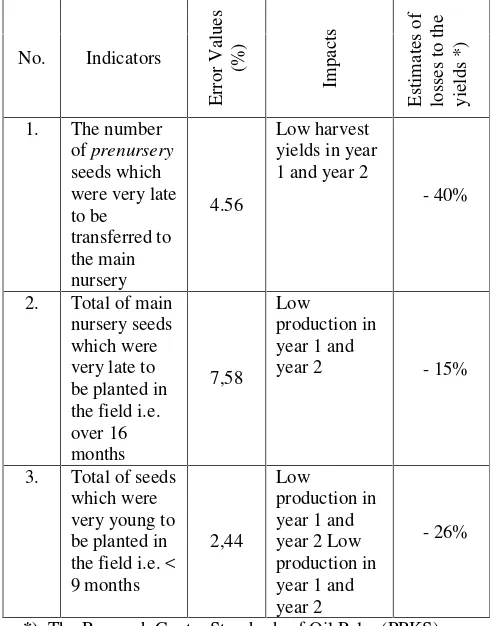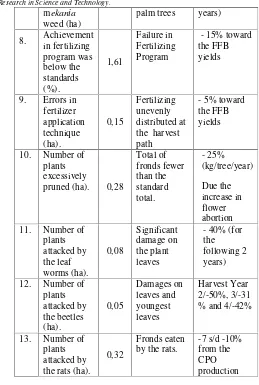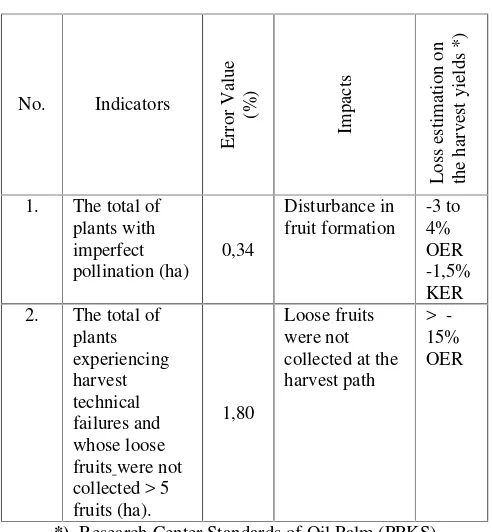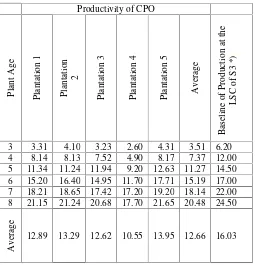International Journal of Latest Research in Scienceand Technology ISSN (Online):2278-5299 Volume 3, Issue 2: Page No19-24 ,March-April, 2014
http://www.mnkjournals.com/ijlrst.htm
ISSN:2278-5299 19
TECHNICAL CULTURE AND PRODUCTIVITY OF
OIL PALM IN SEVERAL PLANTATIONS IN EAST
KALIMANTAN
Rusli Anwar1, Santun R.P Sitorus2, Anas Miftah Fauzi3, Widiatmaka4, Machfud5.
1
Study Program of Natural Resource Management and Environment, Bogor Agricultural University, Indonesia. Pajajaran Street, Bogor 16144 Telp./Fax :0251-8332779.
2,4
Department of Soil Science and Land Resource, Bogor Agricultural University, Indonesia.
3,5 Department of Agroindustrial Technology, Bogor Agricultural University, Indonesia.
Abstract - Plant productivity is determined by two main interrelated factors, namely, the application of technical culture factor, including the use of superior plant materials, and soil suitability factor. Therefore, it was necessary to conduct a research that aimed at finding out the actual productivity of oil palm plantations cultivated and properness of the application of technical culture carried out, and relationship between the application of technical culture and productivity achieved at the level of land suitability of the cultivated land. The study was conducted by taking samples from five oil palm plantations in East Kalimantan with a total area of 85,000 ha ±. The research used primary and secondary data related to the aspects of production, technical culture and land suitability. The secondary data were collected through studies on the enterprises’ reports and research results whereas the primary data were collected by direct observation and measurement of the fields, and then the data were analyzed using statistical analysis. The results showed that the productivity of FFB and CPO produced by the oil palm enterprises in the area of research is still low when compared to the potential baseline of productivity of land with the same suitability classification (S3 or Marginally Suitable) where the FFB productivity reached 78.96% and CPO productivity reached 76.63% of the potential baseline of the productivity of S3 Land Suitability Classification (LSC). The low level of productivity is thought to be caused by the level of application of technical culture which has not met the baseline of the recommended standards of technical culture where the technical culture application errors occurred ranged from 0.05 to 7.58%, and the estimated effect toward the decline in production reached up to 65%. The technical culture application errors occurred in the nursery stage, immature plants (TBM) and mature plants (TM).
Keywords - Palm oil, Technical Culture, Productivity, Plantation, Land Suitability.
1. INTRODUCTION
Productivity of Fresh Fruit Bunches (FFB) and Crude Palm Oil (CPO) per hectare of an oil palm plantation is the most important indicator in measuring the efficiency and effectiveness of the plantation. The productivity of the oil palm plantation achieved at the same time can also be a measure whether the cultivated plantation industry is economically viable. Long-term economic viability of all
palm oil crop production systems relies on the
implementation of best developed practices (BDPs) [1]. Palm productivity is determined by two main factors that are interrelated, namely, the application of technical culture and land suitability. Therefore, it becomes important to know how far the proper application practice of cultivation technical culture has been carried out and to identify the cultivated land suitability classes. For example, the management of palm crop residu for the crop cycle period of 25-30 years can still improve the synchronization of nutrients and beneficial effects from the decay of palm crop residue organics on the soil properties, thus enhancing oil palm production [2].
As it is known that the land suitability classes in East Kalimantan utilized as oil palm plantations currently have a low suitability class, so that the land utilization is in need of supports for the implementation of a good technical culture. Methods of residue management and oil palm planting can increase the spatial integration of nutrient release so that it
can be absorbed by young palm root systems. The management method of palm crop residu for the crop cycle period of 25-30 years can still improve the synchronization of nutrients and beneficial effects from the decay of palm crop residue organics on the soil properties, thus enhancing oil palm production [2].
During the replanting of oil palm, a large amount of oil palm residue available in the soil which contributes about 577 kg N/ha and 40 ton C/ha and root material produced reaches about 65 kg N/ha and 8 ton C/ha. These materials are the main sources of C and N that will affect C and N mineralization in the soil. N mineralization potential, C organic mineralization through soil respiration and CO2 evolution with management practices of different residues can be estimated [3]. Management of nutrient balance (nutrients) is BDPs which are the most important stage, and they have been developed at a specific location and reduce costs in the production of palm oil [1].
International Journal of Latest Research in Science and Technology. mineralized is six to seven times higher than the organic layer underground [3].
These conditions ultimately make the cultivation of oil palm become unprofitable. By knowing the actual picture of the application of technical culture, land suitability classes and the level of productivity of cultivated plantations, an evaluation against the problems that lead to not achieving the productivity potential standard set for the plant varieties can be conducted. This can also answer the complaints of the planters who claim that the actual production achieved is often lower than its production potential.
2. METHOD
2.1. Location and Time of the Research
The experiment was conducted in East Kalimantan Province with the research objects of 5 oil palm plantation enterprises. The determination of the 5 examples was conducted by purposive sampling. Administratively, these plantations are located in Kutai Regency, East Kutai Regency and Paser Regency with a total area of ± 85 225 ha, and the study was conducted from July 2012 to July 2013 (Fig.1).
Fig 1. Research Location
Types and Sources of Data
The primary data were collected by means of observation and measurement, and the secondary data were collected technical culture. The data from the measurement result were analyzed using a statistical method. Evaluation on the technical application of agronomy was divided into 3 groups of activities, namely: Nursery, Immature Plants and Mature Plants. Guidelines for key technical culture and the estimated value of losses incurred due to the technical faults on the production refer to the guidelines published by the [4]. The data of suitability classification data and soil types included the secondary data from the results of land suitability
evaluation conducted by the companies. The guidelines for land evaluation system used were compiled by [5]. Collection and analysis of data on production and productivity were conducted by observations and studies on the plantation production reports and on palm oil factories (MCC). The guidelines for FFB and CPO productivity standards which become the comparator are the baseline standards of the productivity published by the Research Centre for Oil Palm [6]. The results of keys parameters measurement of technical culture are then compared with keys parameters of the Research Centre for Oil Palm. A research on the productivity of the production of fresh fruit bunches (FFB) and crude palm oil (CPO) was conducted and limited to young oil palm trees aged from 3 to 8 years.
3. RESULTS AND DISCUSSION
3.1. The application of key technical culture at the nursery stage
The parameters of the nursery activities evaluated included: the delay in transporting the seeds from the pre-nursery to the main pre-nursery, from the main pre-nursery to the field, and the condition of the seeds transferred to the field. The data from the evaluation results on the application of the key technical culture at the nursery stage showed that the application did not comply with the technical standards recommended (Table 3). The error values of application of the key technical culture ranged from 2.44% to 7.58%, and the errors are estimated to result in losses to yields between 15% in year 1 and 40% in year 4.
Table 3 Recapitulation of the results of the evaluation on the application of technical culture at the nursery stage
No. Indicators
International Journal of Latest Research in Science and Technology.
ISSN:2278-5299 21
3.2 Application of the key technical culture of Immature Plants (TBM)
The data of the evaluation on the application of technical structure of immature plants (TBM) showed that there was an error in the application from the planting to maintenance activities of the plants (Table 4). The error value ranged between 0.05% -1.61%, it is estimated to result in losses to the FFB yields between 0.96% in year 1 and 65% in year 7.
Table 4 Recapitulation of the results of the evaluation of the application of technical culture on Immature plants
(TBM). *). Research Center Standards of Oil Palm (PPKS) Medan
3.3. Application of technical culture at Plant Produces (TM)
The data on the evaluation results on the application of key technical culture in Mature Plants showed that there was a misapplication of the key technical culture at harvest and transport of the harvest yields (Table 5). The error values ranged between 0.34% and1.80% and the error is expected to result in yield losses to between 3% and 15%.
The amount of losses incurred due to errors in the application of technical culture is very influential at the nursery stage on the growth and development of plants when they grow in the field. Nursery health will be influential on
the plants’ adaptability to their field and their resistance to
pests and diseases. Nursery is the first step in planting oil palm whose aim is to provide good, healthy and in sufficient quantities of seeds [7]. From the proper nursery process, superior seeds will be obtained, and this indicates their potential to produce optimal production [8].
International Journal of Latest Research in Science and Technology.
ISSN:2278-5299 22 Immature plants (TBM) will directly or indirectly give
impacts on the growth and development of the plants.
Table 5 Recapitulation of the evaluation results of the errors in the application of key technical culture on
producing plants (TM). cultivation technology (plant maintenance, fertilization, pest and disease control) included in the aspect of Best Management Practices (BMPs) will greatly affect the productivity of plants so that the practices (BMPs) must be conducted properly, and this is in line with the government programs that encouraged the oil palm plantation industries in Indonesia to implement BSM program consistently in order to achieve the productivity targets for an average of 20 tons of oil palm FFB/ha/year in 2025.
The role of oil palm production on Land Use Cover in the future greatly depends on the size of the expansion projected
and agricultural management factors as well as
implementation of best management practices (BMP), earlier replanting with taller harvested plants and development of new plantations on degraded land [10].
Proper fertilization which is part of the implementation of the technical culture has not been properly implemented by the enterprises in the research areas. According to [11], fertilizing management plays an important role in the productivity and profitability of oil palm plants. Sometimes, high price of fertilizer or low price of palm oil also affects the consideration in conducting fertilization. The basic framework of fertilization technique, recommendations, and sufficient knowledge are essential to implement a strategy to overcome the difficulties in dealing with the problem of economic uncertainty regarding the fertilization.
In addition to the fertilizing problem, pest and disease control has also not been optimally conducted. According to [12], Integrated Pest Management (IPM) is the key to the integrated pest control in order to achieve sustainable plantation development. The aim is to adopt the traditional culture, to prioritize the biological or mechanical control so that the hazards of pesticide use can be reduced.
Incomplete pollination and harvest technical errors in Mature Plants (TM) are factors that encourage low productivity of crops. Based on the researches by [6], the number of successfully pollinated flowers was decreasing,
and the bunch weight (berat janjang) was also decreasing
because the fruits in the bunches contain were not solid, thus resulting in extremely low quantity of oil. Harvesting technical faults both for unripe fruits and excessively ripen fruits will affect the CPO produced in terms of both quality and quantity. According [13], the increase of the harvest yields can be achieved through the implementation of Best Management Practices (BMPs), harvest regulation, and fulfillment of the plant population per hectare, and they become the pre-requisites in reducing the yield gaps. However, it should be noted that the success of the program depends on the commitment of BMP top management to provide directions, budget allocations, and other resources, and the plantation-level managers must implement the these practices strictly and efficiently.
Land suitability classification and soil types
The data of evaluation results on land suitability performed by each of the enterprises studied showed that the land suitability classification was S3 (Marginally Suitable) and N (Marginally Unsuitable). The land width of S3 classification (Marginally Unsuitable) was ± 77,985.20 ha or 91% and the suitability classification of N (Marginally
Unsuitable) is ±7,240 ha or 8% of the cultivated land area
(± 85,225.20 ha). According to [14], land suitability
classification is a condition that describes the degree of suitability of a piece of land in the semi-detailed level which will provides information on land suitability which can be applied for the operational needs in the field. As explained by [15] and [16], the suitability is adaptability of land for a particular use.
International Journal of Latest Research in Science and Technology.
ISSN:2278-5299 23 with yellowish red color and become acid with high Al
saturation, and their natural fertility is low.
According to [19], each land characteristic will affect the growth and development of oil palm plants cultivated. High soil acidity, poor soil drainage and coarse soil texture or high content of sand will affect the growth of plants. In regards to soil acidity, the effect mechanism is through an increase of Fe, Al and Mn solubility which are toxic to plants, a decrease in the concentration of nutrient cations, a decrease in P and Mo solubility, inhibition in root growth and water uptake, direct plant cell damage as a result of an increase in the
concentration of H+. In addition, there will be constraints in
nutrient availability and absorption. Meanwhile, the sloping area requires high cost for soil conservation and complicates the process of harvesting and transporting the FFB. The BMP implementation begun with the selection of suitable land will ensure the optimal plant population size, prevent erosion, arrange the planting space, maintain the availability of nutrients by fertilizing based on soil fertility classification, and immediately transport the fruits harvested according to the plantation standard operational procedures (SOP) which greatly determine the productivity of the plantation.
Proper selection of soil is also part of the BMP. Selecting land requires a feasibility study beforehand, and if this feasibility study on the area to be developed is not conducted, it is possible that the land selected may not be suitable. A number of problems regarding its use appear, and to avoid such problems, it is suggested that the best practice for oil palm development involve the initial investigation on the soil or land or land at least through a preliminary study to assess the potential of the land [20].
Productivity of FFB and CPO in the research plantation areas
The research results on the productivity of FFB and CPO of each plantation are presented at Table 4 and Table 5. The average of the productivity of FFB and CPO in the 5 plantations were compared with the productivity baseline potential of FFB in the same Land Suitability Classification (MPA) of S3.
From the evaluation data, it can be seen that the average productivity of TBS on the research areas only reached 12.66 tons/ha/year or 78.96% of the baseline of the productivity potential of FFB at the level of the Land Suitability Classification (MPA) of S3. The CPO productivity also reached 3.87 tons/ha/year or 76.63% of the baseline of the productivity potential of CPO at the level of productivity of CPO at the level of the Land Suitability Classification (MPA) of S3.
The figure of the productivity of FFB in this study was slightly higher than that of the study conducted by [17] who stated that productivity of oil palm FFB in Ultisol soil in the region of Kalimantan was lower than that in Riau and North Sumatra i.e. between 61.2 and 72.7% of the baseline of the production potential on Land Suitability Classification (MPA/LSC) of S3.
This is also consistent with the results of the study conducted by [21] who concluded that the actual productivity achieved in the cultivation of oil palm, in fact, is often not in
accordance with the productivity potential of the cultivated land.
Table 4 The productivity of FFB (tons/ha/year) based on the age of the plants in each plantation company.
Productivity of CPO
*) Research Center Standards of Oil Palm (PPKS) Medan
According to [22], the business agents of the plantation industry should conduct efficient land use through the application of good management practices in the management of oil palm plantations so that land productivity can be improved and becomes more sustainable.
International Journal of Latest Research in Science and Technology.
ISSN:2278-5299 24
Table 5 The CPO productivity (tons/ha/year) based on the age of the plants of each plantation
Productivity of CPO
*S3) Research Center Standards of Oil Palm (PPKS) Based on the research by [23], the average production potential of land of S3 classification (Marginally Suitable) was only 20.1 tones FFB/ha/year with a peak production of 26 tones of FFB/ha/year. However, the production target achieved by the plantations varied and was largely under their production potential.
In addition to land issues, the productivity of FFB and CPO is lower than the standard potential of the production based on S3 MPA S3, and it is assumed that the oil palm enterprises have not implemented the recommended standards of technical culture. Moreover, it can be proved by the data of the evaluation results which showed that there were still a lot of errors in the application of technical culture in the oil palm plantations managed in the research areas. This is consistent with the opinion of [17] who states that besides the land factor, the factor of the application of technical culture which does not follow the norms (baseline standards) also affects productivity. The research results of [4] showed that the errors in the application of technical culture at each cultivation stage resulted in different impacts and caused the decline in FFB production and low suitability classification (S3 or marginally suitable) where the FFB productivity reached 78.96% and CPO productivity reached 76.63% of the potential standard of the productivity. The low level of productivity is assumed to be caused by the level of technical culture application which has not met the recommended standards of technical culture.
REFERENCES
1. Weng ,C. K. 2005. Best-Developed Practices and Sustainable Development of The Oil Palm Industry Journal of Oil Palm Research Vol. 17, p. 124-135
2. Khalid, H., Z.Z, Zin and, J.M. Andeson. 2000. Soil Nutrient Dynamics and Palm Growth Performance in relation to Residue Management Practices Following Replanting of Oil Palm Plantations. Journal of Oil Palm Research Vol . 12 No.1. 2000 p.25-45.
3. Khalid, H., Z. Z, Zin, and J. M. Andeson, 1999. Mineralization of Soil Organic Carbon and Nitrogen in Relation to Residu Management Following Replanting of an Oil Palm Plantation. Journal of Oil Palm Research Vol. 11 No. 2, p 72-88
4. [RCOP] Research Centre for Oil Palm (1999). Evaluation of Crop and Estimation Oil Palm Production in order to Program Analysis and Reseach of Replanted/Extended Oil Palm and Rubber Plant Core in PT. Perkebunan Nusantara XIII, 1999
5. Adiwiganda M.R., P.Purba., F.Chaniago., Z. Poelongan dan T.Hutomo (1995). Pedoman Penilaian Lahan Kelapa Sawit. PPKS. Medan No. IN-9523. pp.16.
6. [RCOP] Research Centre for Oil Palm. (2002). Oil Palm Agriculture. Medan pp.157. 2002
7. Akiyat., W. Darmosarkoro dan Sugiono. 2005. Teknis Pembibitan Kelapa Sawit. Pusat Penelitian Kelapa Sawit. Medan pp. 21. 8. Darmosarkoro W, Akiyat, Sugiono dan S.E Sutarta. 2008. Pembibitan
Kelapa Sawit. Pusat Penelitian Kelapa Sawit. Medan pp. 31. 9. Pahan, I. (2006). Panduan Lengkap Kelapa Sawit. Manajemen
Agribisnis Dari Hulu Hingga Hilir. Penebar Swadaya. Jakarta 10. Wicke, B, R. Sikkema, V. Dornburg, A. Faaij. 2011. Exploring land
use changes and the role of palm oil production in Indonesia and Malaysia. Land Use Policy 28 193–206
11. GOH, K.J., NG, P.H.C. and LEE, C.T. 2010. Fertilizer Management
13. Donough C.R., C. Witt, and T.H. Fairhurst.2009. Yield Intensification in Oil Palm Plantations through Best Management Practice. Better Crops/Vol.93. Southeast Asia.
14. [FAO] Food and Agriculture of Organization 1976. A fame work for land evaluation. FAO Soil Bulletin No. 32
15. Sitorus S. R. P. (2004). Pengembangan Sumberdaya Lahan Berkelanjutan. Laboratorium Perencanaan Pengembangan Sumberdaya Lahan, Jurusan Tanah Faperta IPB. Bogor.
16. Hardjowigeno S. dan Widiatmaka (2007) Evaluasi Kesesuiaan Lahan dan Perencanaan Tataguna Lahan. Gadjah Mada University Press. Yogyakarta
17. Koedadari A. D. (2004). Produktivitas Kelapa Sawit Generasi Pertama Pada Tanah Ultisol di Beberapa Wilayah Perkebunan Kelapa Sawit Indonesia. Pusat Penelitian Kelapa Sawit. Medan hal 39.
18. Subagio H., N. Suharta dan A.B. Siswanto (2000). Tanah Tanah Pertanian di Indonesia. Dalam; Sumber Daya Lahan Indonesia dan Pengelolaannya. Pusat Penelitian Tanah dan Agroklimat. Badan Penelitian dan Pengembangan Pertanian. Departemen Pertanian.
19. Harahap I.Y., Winarna dan E.S.Sutarta (2000). Produktivitas Tanaman Kelapa Sawit: Tinjauan Dari Aspek Tanah Dan Iklim. Prosiding Pertemuan Teknis Kelapa Sawit. PPKS. Medan
20. Paramananthan S. 2002. Best Practices for Sustainable Oil Palm Cultivation– Land Selection and Management . Param Agricultural Soil Surveys. Sdn. Bhd. Implications for Biofuel Production in Indonesia. Ecology and Society 17(1).




